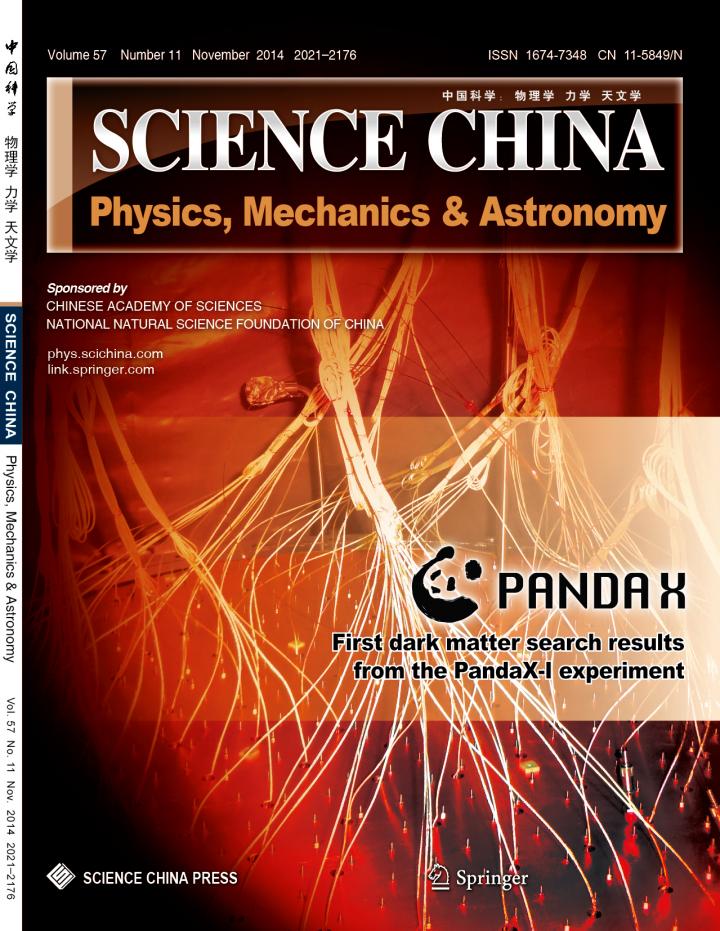First dark matter search results from Chinese underground lab hosting PandaX-I experiment

The front cover of 2014 No. 11 issue of SCIENCE CHINA Physics, Mechanics & Astronomy -- first dark matter search results from the PandaX-I experiment. Credit: ©Science China Press
PandaX is the first dark matter experiment in China that deploys more than one hundred kilograms of xenon as a detector; the project is designed to monitor potential collisions between xenon nucleons and weakly interactive massive particles, hypothesized candidates for dark matter.
In the new study, scientists explain, “Dark matter is a leading candidate to explain gravitational effects observed in galactic rotational curves, galaxy clusters, and large scale structure formation.”
“Weakly interacting massive particles (WIMPs), a particular class of dark matter candidates, are interesting in particle physics and can be studied in colliders [and in] indirect and direct detection experiments.”
If confirmed, dark matter particles would extend understanding of the fundamental building blocks of nature beyond the Standard Model of particle physics, and would provide support for theories on supersymmetry and extra dimensions of space-time.
“Direct positive detection of WIMPs using ultra-low background detectors in deep underground laboratories would provide convincing evidence of dark matter in our solar system and allow the probing of fundamental properties of WIMPs,” they add in the new study.
Direct detection experiments using different technologies have produced many interesting results, but not universally confirmed evidence of weakly interacting massive particles. These results have produced much excitement across the global scientific community and call for further examination of WIMP signals through other experiments.
“In recent years, new techniques using noble liquids (xenon, argon) have shown exceptional potential due to the capability of background suppression and discrimination, and scalability to large target masses,” state the PandaX collaborators. “The XENON10/100 and LUX experiments using the dual-phase technique have improved WIMP detection sensitivity by more than two orders of magnitude in a wide mass range.”
China's PandaX experiment, operated at the China Jinping Underground Laboratory, uses the dual-phase xenon technique to search for both low and high mass WIMP dark matter.
The initial success of the PandaX project demonstrates China has joined the global competition at the scientific frontier marking dark matter searches.
Today more than twenty dark matter search experiments are being conducted worldwide. Many dark matter search experiments, such as the DAMA/LIBRA experiment in Italy, the CoGeNT and CDMS experiments in the US, and the German-led CRESST experiment have reported findings that could be interpreted as positive signals of dark matter in recent years.
The PandaX collaboration joins this effort with results from a dark matter search that started in May of 2014.
No dark matter signal was observed in the first PandaX-I run, which places strong constraints on all previously reported dark matter-like signals from other similar types of experiments.
The PandaX experiment to date has collected about 4 million raw events; only about ten thousand events fell into the energy region of interest for dark matter. In the quiet central part of the xenon target only 46 events were observed.
However, the data from these 46 events was consistent with signals marking background radiation, not dark matter.
PandaX stands for Particle and Astrophysical Xenon Detector. The experiment is being conducted by an international team of about 40 scientists, and led by researchers from Shanghai Jiao Tong University.
The goal of the first stage of PandaX experiment is to examine previously reported dark matter-like signals. The scale of the PandaX-I experiment is second only to that of LUX, which is currently the planet's largest dark matter experiment and is located in a South Dakota mine in the US.
To shield the Chinese experiment from cosmic rays, the PandaX detector is located at the China Jinping Underground Laboratory (CJPL), the deepest underground laboratory in the world. CJPL was developed by Tsinghua University and the Yalong River Hydropower Development Company in 2010.
This research was supported by the 985-III grant from Shanghai Jiao Tong University, the National Basic Research Program of China from the Ministry of Science and Technology of China (Grant No. 2010CB833005), the National Natural Science Foundation of China (Grant No. 11055003) and the Office of Science and Technology in the Shanghai Municipal Government (Grant No. 11DZ2260700). Shandong University, Peking University, the University of Maryland, and the University of Michigan also sponsored the project.
See the article: Xiao M J, Xiao X, Zhao L, et al. First dark matter search results from the PandaX-I experiment. Sci China-Phys Mech Astron, 2014, 57: 2024-2030, doi: 10.1007/s11433-014-5598-7
Link: http://phys.scichina.com:8083/sciGe/EN/abstract/abstract509297.shtml
http://link.springer.com/article/10.1007/s11433-014-5598-7
SCIENCE CHINA Physics, Mechanics & Astronomy is produced by Science China Press, a leading publisher of scientific journals in China that operates under the auspices of the Chinese Academy of Sciences. Science China Press presents to the world leading-edge advances made by Chinese scientists across a spectrum of fields. http://www.scichina.com/english/
Media Contact
All latest news from the category: Physics and Astronomy
This area deals with the fundamental laws and building blocks of nature and how they interact, the properties and the behavior of matter, and research into space and time and their structures.
innovations-report provides in-depth reports and articles on subjects such as astrophysics, laser technologies, nuclear, quantum, particle and solid-state physics, nanotechnologies, planetary research and findings (Mars, Venus) and developments related to the Hubble Telescope.
Newest articles

Properties of new materials for microchips
… can now be measured well. Reseachers of Delft University of Technology demonstrated measuring performance properties of ultrathin silicon membranes. Making ever smaller and more powerful chips requires new ultrathin…

Floating solar’s potential
… to support sustainable development by addressing climate, water, and energy goals holistically. A new study published this week in Nature Energy raises the potential for floating solar photovoltaics (FPV)…

Skyrmions move at record speeds
… a step towards the computing of the future. An international research team led by scientists from the CNRS1 has discovered that the magnetic nanobubbles2 known as skyrmions can be…





















